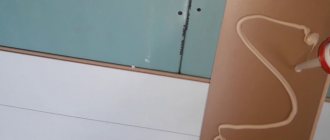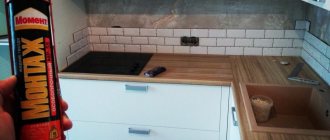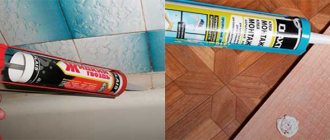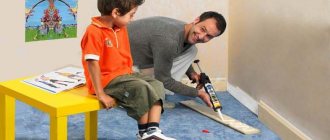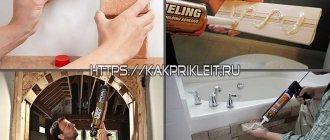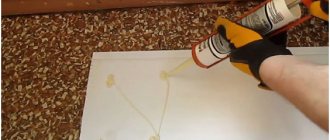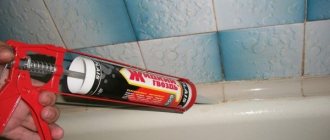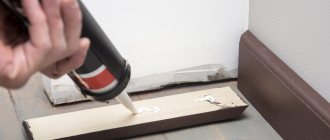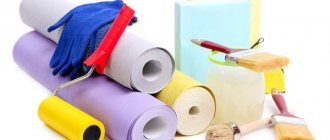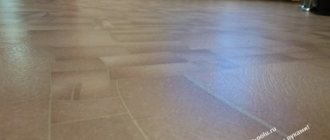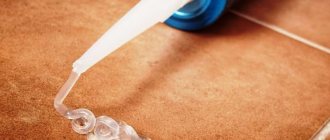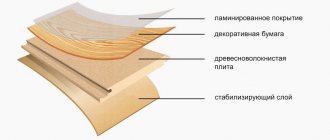PVC panels as wall cladding are popular in non-standard renovations. Many colors, sizes, textures and a relatively low price make this material even more in demand. Before gluing PVC panels to the wall, we recommend that you learn more about their properties and installation methods.
- Characteristics of PVC panels
- Methods for attaching PVC panels to the wall
- Self-tapping screws on the sheathing
- Using clamps
- Adhesive composition
- How to glue PVC panels to a wall with liquid nails: instructions
- Tools
- Consumption
- Wall preparation: leveling
- Work algorithm
- Useful tips
This article contains a description of polyvinyl chloride panels. It covers:
- Their characteristics. Advantages and disadvantages of the material.
- Wall mounting methods.
- Necessary tools, consumption. Tips on how to glue a plastic panel to a wall.
- Instructions on how to apply liquid nails.
- Useful tips for proper operation.
Step-by-step technology for installing PVC panels with glue
Before starting work, you must vacate the premises. To work on the ceiling, you will need a sturdy table or stepladder. It is more convenient to work on a table - there is somewhere to lay out the necessary tools and materials. Let us remind you that fastening plastic panels to the ceiling without lathing with glue is only possible if the base is perfectly even.
The stages of work are as follows:
- Remove all lighting fixtures from the ceiling, determine the points for laying the wires, and mark the zones with a marker.
- Clean the surface of the old coating, removing loose pieces of plaster. The lime and water-based emulsion are washed away with water until the base is exposed, the paint is removed with a spatula and sanded.
- Visually inspect the base, identifying areas with defects.
- Use putty to remove differences in the base, repair cracks and chips.
- You can putty a ceiling with minimal defects, the depth of which is no more than 5-6 mm. If you have to apply a thick layer of putty, it is better to do two layers. Apply the second leveling layer after the first has completely dried and primed.
- Sand the dried putty with sandpaper, prime it and let it dry.
- Pull the cord along the diagonal corners of the room, determine the center - work will be carried out from here.
- Start installing the PVC boards, joining the corners exactly in the center. How to glue PVC panels to the ceiling can be determined by the owner himself by choosing a layout scheme.
All other tiles are laid parallel to the first rows or according to the calculated laying pattern. The layout is clear, but how to glue the plastic panels to the ceiling? The entire perimeter of the back side is smeared with the composition; glue can be applied crosswise, especially in rooms with high humidity levels or when the lamellas are thick. This way the elements will hold more firmly. The lamella needs to be brought to the base, pressed and held for a while, at the same time leveling it. A couple of minutes are enough for adhesion, then the next lamella is laid out.
If the panel does not sit on the base, this means that the surface is not well cleaned or the adhesion properties of the glue are weak.
How to glue PVC panels to the ceiling in this case:
- Remove the elements, clean and prime the ceiling again. Wait until dry, then install the cladding.
- Clean the lamella and base from any remaining glue, coat the panel and ceiling with the mixture, and press down. This “zero” layout provides grip even in difficult cases.
If you cannot solve the problem in any way, then you need to replace the glue by choosing a thicker composition. Epoxy mixtures are suitable for particularly difficult situations, but they should be used in well-ventilated areas and work quickly - epoxy resins have a short pot life.
After finishing the surface, it’s time to finish the corners. For them, plastic corners or ceiling plinths are purchased to cover cracks and layout errors. The elements sit on a transparent sealant - the composition does not expand after drying and does not change the color of the decor.
If you have any questions, watch how to glue plastic panels to the ceiling in the video below in the article. Professional craftsmen will help you understand all the nuances of the work.
Care
Selection of products
For correct care, you need to familiarize yourself with several rules:
- First, protect your eyes, hands, and skin from contact with detergent. Wear personal safety equipment – hat, gloves.
- Remove all hanging items, if present.
- If there are large seams, you need to clean them with a rubber spatula.
- To clean PVC panels, use a soft, non-scratch sponge. For rags, you can use those that do not have lint.
- To protect the casing, do not allow the water to overheat above 40 degrees.
- When choosing a detergent, choose liquid or gel detergents. Powders can leave minor cracks, which become clogged with dust and spoil the appearance of the structure;
- After you finish cleaning the plastic with dust, be sure to rinse the solution with clean water. This way, fading does not occur.
- If the coating of PVC panels is glossy, additional treatment with polish will be required.
- Before using a new detergent, it is advisable to check for reaction with the material. Apply a small amount in an inconspicuous area, then wait 15-20 minutes. If visual changes appear, the product is not suitable for use.
Caring for panels
Using polyvinyl chloride sheets as a facing material for the bathroom is a good choice for people who do not have free time to install tiles or other materials. Quick installation, low cost and an abundance of color schemes are the main advantages of plastic, which is why it has become in demand.
What glue is suitable
Despite the wide variety of adhesives for MDF, their main purpose is to tightly and reliably glue and adhere the panels to the wall. All its types are divided into groups:
- universal compounds;
- special;
- polyurethane foam;
- liquid Nails.
Compounds for MDF stickers
Compounds, or polymer resin, contain “Moment”, “Titanium” and other additives, thanks to which the adhesive is used on wooden, stone, and metal surfaces.
Special Edition
Chemists have developed this series for gluing not only to ordinary surfaces, but also to concrete. It can be used by both professional builders and amateurs who decide to do the repairs themselves. As a supplement to the glue, a gun is used, which makes gluing MDF much easier.
Construction foam
Despite the fact that construction foam is most often used for sealing, its use when installing panels is quite possible. Construction foam is produced in two types - for external and internal use. When fixing MDF panels, it is permissible to use both types of fasteners. After drying, the polyurethane foam remains soft. Flexibility avoids deformation of MDF. This is especially true if their composition is based on wood chip materials.
Liquid Nails
The glue is universal, has high adhesion, resistance to corrosion, and can be used for installation of various building materials, especially those containing wood. Due to its ease of use, the option of using liquid nails is very popular. Using a gun, applying glue is convenient.
Liquid nails based on organic acids have an unpleasant odor, so personal protective equipment should be used. The glue is durable, but if moisture gets in, the seams can come undone. This should be taken into account when renovating rooms where humidity is higher than normal.
Universal construction
Multifunctional adhesive is applicable not only for gluing MDF, but also for other types of repair work. It is characterized by heat resistance (from -30 ⁰С to +60 ⁰С), quickly sets, and is resistant to moisture.
Description of PVC panels
The abbreviation PVC stands for polyvinyl chloride. In fact, it is ordinary plastic, which was given the desired shape during production. PVC panels have been used as a finishing material for many years. This became possible thanks to the undoubted advantages that the panels have. Among them are:
- Durability, service life up to 10 years.
- Easy to care for.
- Environmentally friendly.
- Moisture resistance.
- Fire safety.
- Resistance to low and high temperatures.
- Good sound insulation.
- Can be attached to different surfaces and the like.
Many customers also like the fact that the stores offer a huge number of colors, with a variety of designs printed on the panels. If you want to make an inexpensive but beautiful renovation, then this material will be a good choice.
The main thing is to choose a good manufacturer and pay attention to possible defects in the product
The panels are easy to buy and, importantly, easy to install
There are two main ways in which you can attach plastic panels to the wall:
- Attaching panels to the frame. This can be done mechanically, that is, using screws, nails or staples. The sheathing itself can be metal, wood or plastic. The panels can also be glued to the frame, which in this case will act as a wall leveler. This method of fastening - to the sheathing - has its pros and cons. Those who don't want to spend too much time installing the frame and lose precious square centimeters in the bathroom can choose a different route.
- Gluing to the wall. This method has virtually no effect on the area of the room being repaired. But it has its limitations. The walls must be smooth, dry, and the adhesive composition must be well selected, then the repair work will give the right result.
You must understand that not every glue is suitable for attaching this finishing material. Some compounds may damage the plastic or do not withstand moisture well. Therefore, it is better to know in advance than to glue PVC panels to the wall.
Liquid Nails
Probably no repair can be done without this fastener. This product has also proven itself well in finishing work using plastic panels. Liquid nails are very easy to use, and they do an excellent job of attaching polyvinyl chloride to a wall or sheathing. But when purchasing, you need to carefully choose the right composition. Some products are too strong and their use may cause the plastic surface to swell.
Among the liquid nails that are usually used for gluing PVC finishing materials are the following:
- Liquid nails 601. They can be used when working with different types of materials, including PVC. The product dries within 10 minutes, which gives time to correct mistakes if the slab was attached unevenly. However, some craftsmen do not recommend using this composition when renovating bathrooms and toilets, since it has insufficient moisture resistance.
- Liquid nails 901. This product can be used both for interior decoration and for exterior work. Its main advantages are versatility, durability and strength. This composition is capable of holding even heavy coatings.
- Liquid nails 915. This substance is ideal for repairs in the bathroom or other rooms where there is high humidity. The composition prevents water from penetrating the wall surface, which protects the room from mold and other troubles.
In general, the use of such funds is quite justified. Perhaps there will be some subtleties when installing PVC plates. It is better to read the instructions in advance so that the polyvinyl chloride is firmly attached to the wall surface.
What to look for when choosing glue
To properly glue PVC panels to the wall, you need to remember that this material has a smooth surface, flexible and light structure. Therefore, not all types of adhesives are suitable for attaching plastic trim. Some compositions can deform, change color, or completely melt PVC elements.
However, the inflated price does not mean that the solution can be used for finishing PVC. Before installing the panels, ensure that the bonding component meets the following requirements:
- Plastic panels are popular for finishing walls in bathrooms, showers and other rooms with high humidity. Therefore, PVC glue must be resistant to water and temperature changes.
- After drying, the solution should remain colorless and not turn yellow over time.
- Have high adhesive properties to complex and porous surfaces.
- The setting time should be no more than 15 minutes. And the time to adjust segments is more than 3-5 minutes.
- The composition should not contain chemically aggressive reagents hazardous to health. If the solution has a strong chemical odor, it is better not to use it for interior work.
- The adhesion mixture must have a medium viscosity to remain on vertical surfaces. Formulations that are too liquid may drip.
- It is better to give preference to materials that contain fungicides. This will prevent the development of mold and fungal growths.
- The clutch must be durable (at least 5-7 years).
- The glue should create an elastic grip and not crumble over time. Withstand temperature changes in the range of 25˚C.
- For ease of application, it is better that the packaging is equipped with a dispenser tip. Immediately before starting work, the tip is cut off. The higher the cut is made, the thicker the layer of glue will come out.
- If PVC elements are intended for rooms with natural light, the adhesive must be resistant to UV rays.
- When installing PVC tiles on the “Warm Floor” system, the adhesive must have heat-conducting properties and withstand regular heating up to 75˚C.
For installing PVC panels, there are special adhesive materials that meet all the requirements for working with vinyl coverings. Some of them are two-component. In this case, the packaging consists of two isolated components. Immediately before fastening, both elements are mixed. However, to save time, it is better to buy ready-made mixtures.
In addition to special adhesives, you can also use liquid nails. These are universal solutions that are suitable for many types of textures and materials.
When using liquid nails and special adhesives in tubes, you may need a nail gun. It facilitates the application of glue and distributes the glue economically over the entire surface.
Material characteristics
Polyvinyl chloride, or PVC, is a modern finishing material. The service life of such panels with proper installation reaches 10-15 years. They are resistant to temperature changes, moisture, and are not afraid of mold and mildew. They are durable and can withstand mechanical loads. PVC provides good sound insulation, and this is not all the advantages of the finishing material. It is mainly used for the renovation of bathrooms and bathrooms, but is also used in the decoration of loggias, balconies, offices and other premises.
Installation of such panels is carried out either with self-tapping screws or with special fastenings - staples and clamps. An alternative option is PVC glue. It is convenient to work with, it allows you to carry out repairs yourself without wasting time and money. Even those who do not have much knowledge in the construction business can handle it.
Wall covering with PVC panels in the interior of different rooms
Covering walls with PVC panels will be relevant for different rooms, but do not forget about some combinations that may look the most successful. Below are the basic tips for creating a successful and efficient home interior.
PVC wall panels for kitchen
The kitchen is a room with high humidity and temperature - a large number of sources of moisture and heat contribute to the rapid deterioration of any finishing materials. PVC is quite sensitive to temperature, so when deciding to use it, the most important factors should be taken into account.
In the kitchen
First of all, when choosing PVC wall panels, you should still add tiles or another type of tile in order to limit the washing and cooking area. Plastic does not tolerate heat well, and after a while the panels next to the stove are seriously deformed, and then completely melt.
According to the design, mosaic options are perfect for the kitchen - they often imitate a tiled floor. Also, a good option would be to build a stone or wooden surface, especially if this kitchen is located in a private house or is a summer kitchen.
Decorating toilet walls with PVC panels - photos of interesting ideas
Decorating toilet walls with PVC panels (photo below) is a great idea - the panels do not absorb odor, are protected from water and are easy to clean. They can be attached directly to relatively flat walls using sealant or glue, but you can also create a frame that will hide all the wires and pipes.
In blue
Ideas in this case are also not limited - any solutions can be used. Mosaics, 3D options, stone and wood are perfect
Also, you should remember about compatibility with the floor covering - in the toilet this is of particular importance
PVC wall panels for bathroom
A bathroom is similar to a toilet in many ways. PVC panels for walls in it have exactly the same advantages, which allows you to fully use them. In this case, it is better to avoid frames - they rarely create a truly sealed surface
This is important when placing panels near the bathtub, since water from it very often gets on the walls
In olive tones
Among textures, it is better to avoid wood - for a bathroom it will look too unusual, giving off a fake. The remaining options are perfect regardless of the room - 3D looks especially advantageous, as it allows you to create a special interior.
On the balcony
PVC panels can perfectly complement plastic or aluminum windows on the balcony. There are no special requirements in this case - the main thing is that the products can withstand negative temperatures. In addition, we must take into account that the balcony is extremely open to all light sources. Ultraviolet radiation very quickly destroys various paint coatings that are applied to panels.
With boxes
In this case, the most optimal solution is to use colorless panels - for example, white. They are made without applying paint, which means you don’t have to worry about fading. Placement is permissible directly on the walls, since on balconies they are most often flat. It is worth using adhesives that are resistant to negative temperatures. Later in this article we will look at how to properly attach PVC panels to the wall on a timber profile.
In the living room
Panels in living rooms are used quite rarely. Full finishing with their help is irrational - covering the entire surface with wallpaper is much easier. Using PVC you can create individual elements. For example, a great idea is to create a wood or stone finish for the lower half of the wall.
Country style
Another idea could be to create additional surfaces from 3D panels
This will diversify the room, but you shouldn’t make them too noticeable and bright - it distracts too much attention to itself, making the interior less uniform
Main varieties
At the moment, PVC wall panels (catalogue, photo, price will be presented at the end of the article) are presented in a fairly wide range. This is achieved both through various forms and textures. The most common forms include:
- tiled;
- rack and pinion;
- leafy.
In the living room
All types have their own purpose, both in terms of their location in the rooms and how they work with the surface. This needs to be taken into account when choosing material as it can seriously affect performance.
Tiled
PVC tiled wall panels for interior decoration are small tiles that can be laid like regular tiles. The main difference from it is its significantly low weight, which allows the use of ordinary glue or sealant.
Tile panels in the bathroom
The size of the tiles varies from large, 500x500mm, to very small, 50x50mm or even smaller. Their use allows you to achieve different visual effects by typing different drawings and even full-fledged images. Also, tiles are much more convenient in rooms where the walls have different sizes and problem areas that would be difficult to cover with other types of panels.
Rack and pinion
This type of PVC wall panels is considered classic. The slats are narrow (up to 300-400mm), long panels that look like clapboard. They make it easy to cover any vertical surfaces and ceilings, and due to their standardized sizes they have a wide variety of colors and shades.
How to attach PVC panels to the wall - more details later in the article.
The dimensions of the slats allow them to be used in any room. With them, work proceeds most quickly - they simply stick to each other, creating a continuous wall covering. For added continuity, various sealants and putties can be added to the gaps between them.
In addition, we must take into account that slats are not convenient in all places - for example, in rooms with sloping ceilings they will require additional cutting, which is sometimes quite complicated. Also, the slats do not withstand different pressures well, as do all PVC panels, and all fastening elements must be secured under them, cutting out slats for them.
Leafy
Sheets for covering walls with PVC panels are made in the form of flat sheet material. The sheets themselves vary in size, providing a fairly wide range. They can be used both for figured cutting and for full wall covering.
PVC sheet options
Installation process
When installing PVC panels on the wall, you need to take into account that changes in environmental conditions can affect the condition of the material. Therefore, when adjusting the panels in height, it is better to leave a small gap.
Before attaching PVC panels to the wall, you should remember that:
- If the slats are attached with nails to the sheathing, then it will not be possible to reuse the material, since it will be practically destroyed during the dismantling process.
- The best fastening option is with clamps. But another popular method is using staples, which are driven in with a special stapler.
Moldings allow you to obtain a holistic pattern and improve the appearance of the panels. Source doma125.ru
Installation is carried out in several stages:
- First, the fittings are placed. For large panels that will cover the entire wall from bottom to top, it is recommended to add a ceiling plinth to the top beam.
- The panel is inserted into the mount and secured with nails or staples. After this, check how evenly the first panel is installed.
- After this, proceed to the next panel, which is inserted with its narrow end into the groove of the previous one; such actions are performed until all elements are installed.
- If the dimensions of the PVC panel are not suitable in width, then cut off the excess with a knife, moving it along the panel. It is advisable to carry out the procedure so that the slats fit tightly to each other.
When installing panels yourself, they often use glue and lathing installation options, but professional workers can also use more complex methods.
Review of effective brands
Among the above groups of glue, several brands with high performance have gained the most popularity. According to reviews from professionals, when choosing, you should give preference to such brands.
Titan wild
Glue belongs to the group of liquid nails and is a universal professional product. The Titan wild composition successfully replaces fastening with screws, self-tapping screws or nails. The glue is capable of fixing MDF panels on any surface. It is used both indoors and outdoors. The advantages of the brand include:
- reliable fixation without damaging the structure of the material;
- moisture resistance - 100%;
- cost-effectiveness;
- setting speed;
- Possibility of use at different temperatures.
Titebond
The adhesive is based on an aliphatic resin. It is used in carpentry for gluing wooden parts, applying laminate, MDF, chipboard, and assembling furniture. The advantages of Titebond glue include:
- fast setting;
- readiness to work;
- resistant to moisture, heat, solvents;
- ensuring the strength of the bonding boundary is much higher than that of wood.
The glue has the appearance of a viscous yellow emulsion, after drying it is translucent. Resistant to freezing, ignites when temperatures exceed 100 ⁰С.
"Moment-1"
Universal adhesive “Moment-1” is perfect for gluing surfaces made of different materials, is moisture-resistant and can withstand temperatures from -40 ⁰С to +110 ⁰С. The glue dries very quickly thanks to the components included in it:
- rubber resins;
- rosin;
- ethyl acetate;
- acetone;
- hydrocarbons.
Glue "Moment-1" is a light yellow thick liquid. The optimal temperature for work is from +18 ⁰С to +25 ⁰С. When attaching the panels, air flow should be ensured to avoid poisoning by toxins.
Tytan Euro-Line 601
Adhesive is a type of universal construction adhesive. It is used indoors and outdoors. The base on which MDF is mounted can be made of wood, concrete, brick, or plaster.
Tytan Euro-Line 601 adhesive is based on rubber. It is used for repairs and finishing with MDF panels. The main characteristics include:
- strong and fast grip;
- strength;
- hardening within 24 hours;
- heat resistance ranging from -30 to +60
"Moment Crystal"
The glue is colorless, transparent, dries quickly and leaves no marks as a result of working with it. Liquid nails reliably fix MDF panels installed on the ceiling or walls indoors. "Moment Crystal" is well suited for gluing panels without top finishing.
The peculiarity of this variety is that the speed and reliability of setting depends on the force with which the surfaces were pressed. “Moment Crystal” is characterized by high frost and moisture resistance.
Makroflex MF220 Heavy duty
This brand of glue is intended for joining different materials:
- MDF;
- drywall;
- polystyrene foam;
- chipboard;
- metal;
- ceramics;
- wood;
- gypsum
The form of the glue is a white paste based on polyacrylates. The optimal temperature for fixation is +10 ⁰С and above. Among the characteristics of Makroflex:
- maximum holding time - 15 minutes;
- no odor;
- Possibility of use outdoors and indoors;
- great gripping force.
Liquid Nails LN-910 Panels
This brand of liquid nails is indispensable for quickly covering a room with panels, gluing decorative elements, baseboards, and moldings. The adhesion is reliable if brick, concrete, wood, plywood, chipboard and other materials are used as the base.
The adhesive is intended for interior use. It is distinguished by a number of characteristics:
- elasticity;
- the ability to adjust the gluing within 15 minutes after connection;
- obstacle to deformation;
- long (up to 20 years) service life;
- ability to freeze and defrost.
Liquid Nails LN-901 Heavy Duty
The composition is based on synthetic rubber. Capable of creating the strongest connections in difficult conditions. Can be used both indoors and outdoors. Sets quickly. Can be used at temperatures from -40 ⁰С to +70 ⁰С. The following materials are used as glued materials:
- MDF panels;
- tree;
- brick;
- tiles;
- cork;
- plywood;
- drywall.
Temperatures from -40 °C to +70 °C are optimal for operation, from +5 °C to +38 °C - for work.
Fastening without sheathing
The best solution would be to glue the panels. The procedure is simple, you don’t need to have any special skills, drill anything, etc. Here we describe how to glue PVC panels to a wall using “liquid nails”, however, you can use other adhesives, we will also look at them.
Arguments against lathing:
- When the panels are glued close to the wall, it is more difficult to make a dent in them; they rest directly on the wall. Voids in the sheathing, on the contrary, facilitate accidental damage to the plates.
- It will be difficult to attach something large and heavy to such a wall.
Selection of adhesive composition
There is, so to speak, enough assortment.
You need to pay attention to the following:
- Moisture resistance;
- Resistance to significant temperature changes;
- Hardening speed and reliability of fixation;
- Transparency of the dried composition (if this matters to you)
We immediately discard hot-melt adhesive, since it has a high coefficient of thermal expansion.
You can use “liquid nails,” adhesives for polyvinyl chloride, and polyurethane sealants.
The following compositions performed well:
Kleyberite
German formulation based on artificial resins.
- Resistant to dampness
- Homogeneous in consistency
- Economical consumption
- Quick drying
- Ecologically pure
- Different packaging
Glue – KLEIBERIT
Emphicol
Manufactured in Russia, designed for gluing polymers. It is transparent and, after curing, holds the panel well on any rough surface.
- Suitable for various substrates
- Moisture-resistant, withstands temperature changes
- Resistant to condensation
- Quick drying
- High strength
Moment Crystal
It has good adhesive properties and is colorless. Often used for installation of various plastic structures and suspended ceilings.
Glue – Moment “CRYSTAL”
Tital Wild
A solution of polyvinyl acetate copolymers in a solvent (judging by the smell - ethyl acetate). Good glue too.
Glue TITAN WILD
Liquid Nails
Instead of glue, formulations based on synthetic rubbers under the general name “liquid nails” are also suitable for our purposes. An almost universal product, compatible with many surfaces.
Using liquid nails, you can glue plastic parts, therefore, PVC panels will also stick to the wall.
Types of liquid nails
There are two formulations on the market:
- Neoprene, contain organic solvents. They have good adhesion properties and are resistant to dampness and temperature changes. Users note a rather persistent specific smell that lasts for a couple of days.
- Acrylics are water-based, they are more environmentally friendly, but less practical: they are afraid of water.
Titan Wild
This type of liquid nails is used not only for PVC, but also for heavier structures (plasterboard, metal, cement sheets). Used for ceiling plinths. It is mechanically stable after hardening and is not afraid of temperature changes.
Liquid nails – TITAN WILD
Quality
Professional formulation used in construction and finishing. The color after hardening is white, which somewhat limits its applicability in the installation of PVC panels. Dries quite quickly.
You can determine whether the glue is suitable for you on a small piece of surface: take a piece of plastic and glue it to the base according to the instructions. In a day, tear it off, and everything will become clear.
Liquid nails – QUALITY
What to look for when choosing
It is clear that the choice begins with color and pattern. But to avoid any difficulties during the installation process, you need to keep track of some points when purchasing:
Inspect the cut of the selected plastic panel. The thicker the lintels and the front and back layers of polymer, the stronger the finish. You can also focus on weight - the greater it is, the thicker the panels will be. The thickness of the plastic is the same everywhere, without thickening or thinner places
This is a sign of normal quality. Pay attention to the geometry. The cells should not be wrinkled, the edges should be absolutely straight
Even if everything is packed, it doesn’t hurt to unpack and inspect it so that there are no problems later. Inspect the front surface. The pattern should be applied evenly, clearly, without blurry spots. If you choose panels from different packs, but of the same color, carefully look at the colors - they may differ.
It is also worth checking the quality of the polymer used. You need to take one plank so that it bends by about 30% and straighten it. After that, examine it. If there is no damage to the plastic or pattern, everything is fine.
How plastic panels are glued: how to figure it out?
The finishing of walls and ceilings with plastic is carried out using a specially prepared metal or wooden frame to which panel sheets are attached. Recently, gluing sheets rather than mounting them on a frame has become increasingly popular. This method saves 3-4 cm of total space, and also prevents the appearance of dampness and rot on the walls between the profiles. What is the alternative to installing panels with glue?
How to glue a PVC panel: requirements for walls
Naturally, not every coating can be coated with glue and not every coating can be glued to another element. PVC panels are fixed according to certain laws, for non-compliance with which you can pay with your own money and invaluable time.
- Surface evenness. There should be no distortions or roughness on it, except for this, holes or differences of no more than 4-5 mm. If it is exceeded, the plastic simply will not stick or will be broken.
- Surface condition. It is a well-known fact that it is difficult to stick anything to a greasy and dusty surface. This means you must clean the panels and wash off the whitewash and dust, and get rid of the grease using household chemicals.
How to glue PVC mosaic and choose glue
The most correct option for gluing PVC is “Moment” assembly adhesive, which is intended for technical and decorative gluing of parts.
When using this glue, a pistol technique is used, which allows it to be applied pointwise.
In addition, there are also such adhesives: liquid nails, polyurethane foam and tile adhesive (cement). All of them easily perform their immediate function, but each of them is not perfect.
If we talk about thermal adhesives, then it is worth remembering the ability of plastic to expand, which can lead to sheet lag. This pitfall will manifest itself over time, when, under constant thermal influence, the sheet simply will not have a place to expand, but instead will fall off completely.
Liquid nails do not cause such situations, but it is best to use a non-expanding sealant, which is sold in every hardware store. It is plastic and heat resistant. Professionals use only it.
Application benefits
The main advantages include:
- Wide range of use. In addition to the classic use for finishing walls, PVC is involved in the production of door and window slopes, kitchen aprons. The material is lightweight, versatile and cheap.
- Design. In addition to the traditional white sheet color, manufacturers also produce other options. There are plastic panels that externally imitate tiles, paintings, mosaics and frescoes. If desired, you can order a print on plastic sheets;
- Durability and stability. The material has high tensile strength. If the production technology is correct, then the fracture strength is also high. Durable, ceiling plastic is almost impact-resistant.
- Simple and fast installation process. Due to the low weight and production technology, in which the panels are connected to each other using the tongue-and-groove method, installation on the wall is very simple even for beginners. For smooth surfaces, you can install the sheathing with glue. If there are bends, you will have to level the wall or install a frame.
- Easy care. The finished structure is smooth and easy to clean. All you need is a cloth with soapy water. However, there may be problems with cleaning the joints.
Possible decor options
